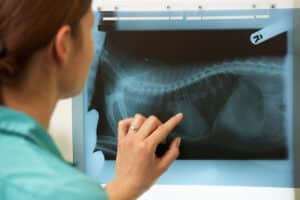This month is National Pet Dental Health Month and one of the questions we commonly get asked at Creekside is “Does my pet really need to have a dental cleaning?” Simply put, the answer is yes. Many pets (80% of dogs and 70% of cats) have entered the early stages of dental disease by the age of 3. With the main cause being the build up of dental tartar, the infection progresses and compounds as the pet goes longer and longer without a proper dental cleaning.
We understand that pet owners have a lot questions about dental procedures for their pets, so we made a quick guide below so that you can feel confident about giving your pet the best dental care possible!
What causes dental disease for pets?
The main cause for dental disease or dental periodontitis is the same for pets as it is for humans – bacteria! Dental and gum diseases are an infection resulting from build-up of soft dental plaque on the surfaces of the teeth around the gums. Almost immediately after an animal eats, bacteria, food, saliva, and other particles, begin forming a sticky film called plaque over teeth.
How do you diagnose a dental disease?
This may seem complicated – and it can be – but if you strip it down to the four most simple stages of dental periodontitis it’s much easier to understand.

How do I know if my pet has dental disease?
- Bad Breath
- Loose teeth or teeth that are discolored
- Protecting or shying away from letting you check their teeth
- Drooling or dropping food while eating
- Bleeding from the mouth or gums
Could my pet be in pain?
Our pets have a strong natural instinct to hide pain, so this can be difficult to recognize. Many times they will mask the pain and owners may not even notice a difference in their pet’s eating or day-to-day routines. This is why our pets will continue eating, even if their teeth look or smell bad. Some lesser known indications of pain include increased licking, altered or heavy breathing, changes in posture, and changes in sleep habits.
Why do you use anesthesia?
While there are multiple reasons for anesthesia, the most important is that it maintains the safety and comfort for your pet. Evaluating and cleaning your pet’s teeth is a delicate process that requires a good amount of time. Have you ever tried to brush your pet’s teeth? It can be difficult. Now imagine trying to work on their month for an extended period of time! Without anesthesia your pet would have to restrained, leading to stress and tension. Using it allows us to mobilize the pet to clean the gums (where the problems lie), control pain, and place a tube into the windpipe to stop bacteria from the respiratory system.





